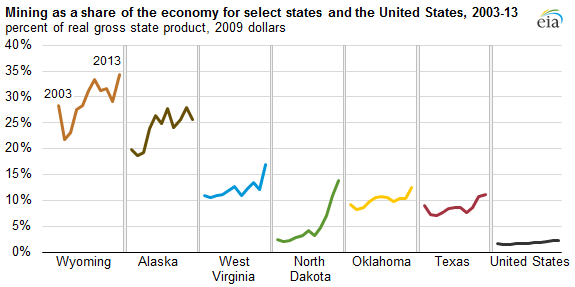How big a deal is American energy extraction?
At the national level in the US, establishments that extract crude oil and natural gas as well as naturally occurring mineral solids, such as coal and ores, collectively referred to as the mining sector in economic data, accounted for about 2 per cent of the economy last year.

Source: US Commerce Department, Bureau of Economic Analysis, Regional Economic Accounts
In some states, though, the mining sector accounts for a much larger share of the economy. Of the six states where mining comprised more than 10 per cent of the state's economy in 2013, mining growth resulted in five of those states having higher economic growth than the national average.

Source: US Commerce Department, Bureau of Economic Analysis, Regional Economic Accounts
Wyoming
With crude oil and natural gas production from the Niobrara formation and coal mining from the Powder River Basin, Wyoming derives a larger share of its economic output from mining than any other state. In 2013, Wyoming's economic output from mining grew 18 per cent between 2012 and 2013.
Alaska
Alaska has the second-largest share of its economy tied to mining activity. An 8 per cent decrease in mining activity in 2013, reflecting a drop in oil production from the North Slope, contributed to the decline of Alaska's total GDP by 2.5 per cent in 2013, the largest decline in the nation.
West Virginia
Most of West Virginia's mining activity is from coal mining, but natural gas production from the Marcellus shale in West Virginia has increased in recent years. The sector grew from 11 per cent of total economic activity in 2003 to 17 per cent in 2013.
North Dakota
In percentage terms, North Dakota has experienced more change in its economic makeup from mining activity than any other state, going from 2 per cent of its economy in 2003 to 14 per cent in 2013. North Dakota's crude oil production surpassed 1 million barrels per day in average monthly oil production earlier this year, because of production in the Bakken region. Associated effects from Bakken development, such as growth in construction, real estate rental and leasing, and accommodation and food services, also increased economic output. Growth in the mining sector has helped North Dakota achieve the lowest unemployment rate in the nation at 2.7 per cent as of June.
Oklahoma
Oklahoma has significant oil and natural gas production, ranking fifth nationally in the volume of crude oil production and fourth in natural gas production. The state saw 19 per cent growth in mining activity, up from its 10-year average of 7 per cent. Oklahoma’s significant refining and transportation activity is not included in the mining sector data.
Texas
In absolute terms, mining activity in Texas in 2013 was more than seven times greater than the next largest state, Oklahoma. But compared to the states discussed above, Texas’s economy is much larger, so mining only accounts for about 11 per cent of its economy. Much of the recent growth in mining has come from rapidly growing oil and gas production in the Eagle Ford formation and Permian Basin.
Originally published by the US Energy Information Administration. Reproduced with permission.
















